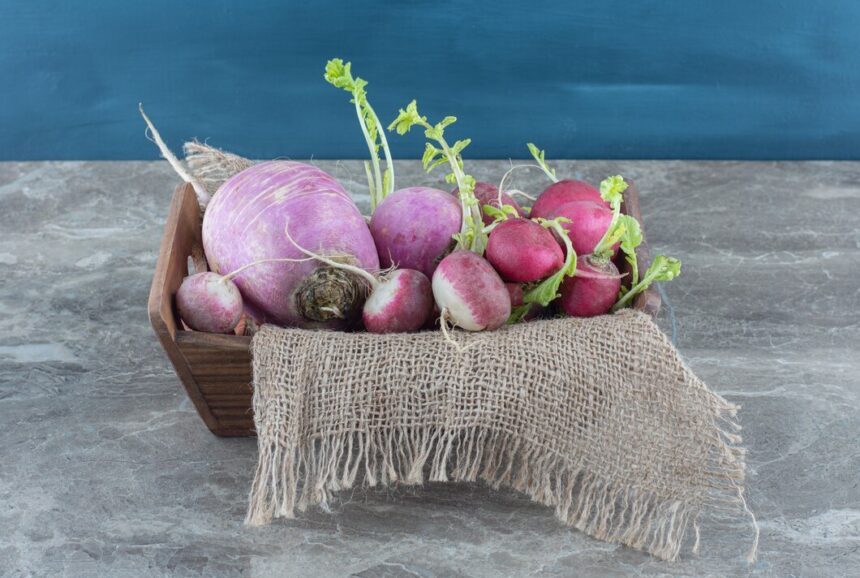Turnips are a versatile and nutritious root vegetable that can thrive in South Africa’s diverse climates. Whether you are a smallholder or a commercial farmer, understanding the complete process of growing turnips—from seed to harvest and storage—can help maximize your yield and ensure high-quality produce. This guide outlines the growth stages, required inputs and machinery, management of pests and diseases, and tips for successful cultivation.
1. Land Preparation
Soil Type: Turnips prefer well-drained, loamy soils with a pH of 6.0 to 7.5. Soil that is too acidic or too compacted can hinder growth. Conduct a soil test to determine nutrient levels and pH.
Land Preparation:
- Tilling: Use a plough or rotary tiller to break up the soil to a depth of 15-20 cm. This improves aeration and drainage.
- Weed Control: Remove any existing weeds by tilling or manual weeding, as turnips are sensitive to competition during early growth.
- Fertilization: Incorporate well-rotted manure or a balanced fertilizer (such as 10-10-10 NPK) into the soil during preparation to provide essential nutrients.
2. Sowing Seeds
Timing: Sow turnip seeds in early spring or late summer. In South Africa, the ideal planting months are from March to April for autumn harvest and from August to September for spring planting.
Seed Sowing:
- Spacing: Sow seeds 1-2 cm deep, with a spacing of 15-30 cm between rows and 5-10 cm between seeds within the row.
- Machinery: A seed drill can be used for large-scale planting, while manual sowing is suitable for smaller plots.
3. Watering
Water Requirements: Turnips need consistent moisture, especially during germination and early growth. The soil should be kept moist but not waterlogged.
Irrigation Frequency:
- Germination Phase: Water every 2-3 days until the seeds germinate, which usually takes 7-14 days.
- Growing Stage: Once established, reduce frequency to once a week, ensuring about 2.5-5 cm of water per week. Adjust based on rainfall and soil moisture levels.
4. Fertilization
Nutrient Management:
- Initial Fertilization: Incorporate balanced fertilizer at planting.
- Side Dressing: About 4-6 weeks after emergence, apply a side dressing of nitrogen-rich fertilizer (such as ammonium nitrate) to promote healthy leaf and root development.
5. Growth Stages
Germination (0-2 Weeks):
- Monitor soil moisture closely during this stage to ensure successful germination.
Seedling Stage (2-4 Weeks):
- Thin seedlings to prevent overcrowding, leaving the strongest plants spaced adequately. This promotes healthier root development.
Vegetative Growth (4-8 Weeks):
- Continue to monitor for weeds and pests. Ensure the plants receive adequate water and nutrients.
Maturation (8-12 Weeks):
- Turnips typically take 8-12 weeks to reach harvestable size, depending on the variety. The roots should be firm and reach about 5-10 cm in diameter.
6. Pest and Disease Management
Common Pests:
- Cabbage Root Fly: Look for signs of wilting or stunted growth. Use insect barriers or apply insecticides such as pyrethroids.
- Aphids: Monitor for sticky residue on leaves. Control with neem oil or insecticidal soap.
Diseases:
- Downy Mildew: Look for yellowing leaves and downy growth. Ensure good air circulation and apply fungicides if necessary.
- Black Rot: Affects the leaves and stems, leading to yellowing and wilting. Rotate crops and use resistant varieties to manage.
7. Harvesting
Timing: Harvest turnips when the roots are 5-10 cm in diameter, typically 8-12 weeks after sowing.
Harvesting Techniques:
- Use a spade or fork to gently lift the roots from the soil. Be careful not to damage the roots during harvest.
- Harvest in dry conditions to reduce the risk of rot during storage.
8. Storage
Post-Harvest Handling:
- Remove any excess soil and cut off the tops, leaving about 2.5 cm of stem to prevent moisture loss.
- Store turnips in a cool, dark place with high humidity (around 90-95%) to prolong shelf life. Ideal storage temperatures are between 0-4°C.
Long-Term Storage: Turnips can be stored in perforated plastic bags or containers in the refrigerator for several weeks or in a root cellar for longer storage.
Growing turnips from seed to harvest requires careful planning, attention to detail, and proactive management of pests and diseases. By following these guidelines, South African farmers can successfully cultivate turnips, ensuring healthy crops and maximizing their yield. With proper care, turnips can provide a nutritious and versatile addition to your farming operation.
Join 'Farmers Mag' WhatsApp Channel
Get the latest Farming news and tips delivered straight to your WhatsApp
CLICK HERE TO JOIN






